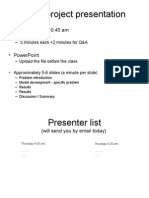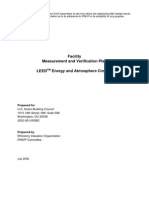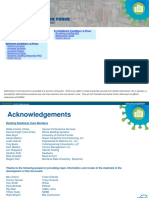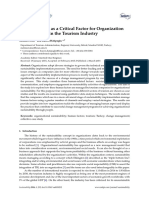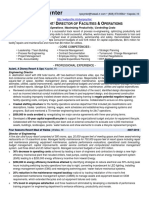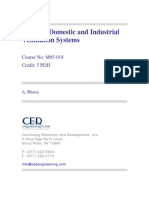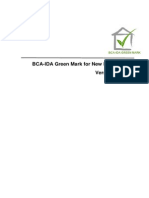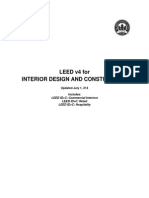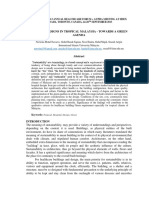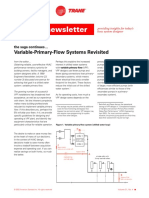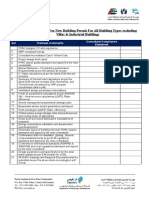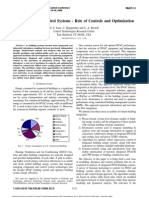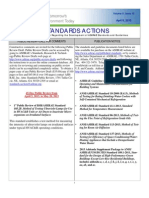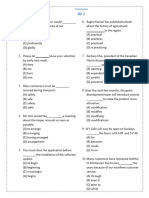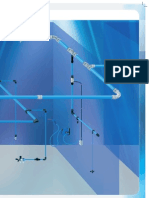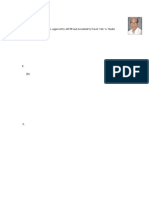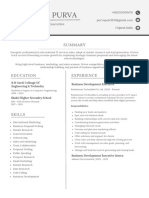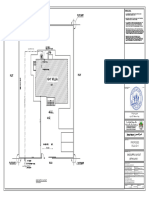Modulo 3 Procedures For Comm Buildings Energy Audits
Modulo 3 Procedures For Comm Buildings Energy Audits
Uploaded by
pixelnutCopyright:
Available Formats
Modulo 3 Procedures For Comm Buildings Energy Audits
Modulo 3 Procedures For Comm Buildings Energy Audits
Uploaded by
pixelnutOriginal Title
Copyright
Available Formats
Share this document
Did you find this document useful?
Is this content inappropriate?
Copyright:
Available Formats
Modulo 3 Procedures For Comm Buildings Energy Audits
Modulo 3 Procedures For Comm Buildings Energy Audits
Uploaded by
pixelnutCopyright:
Available Formats
Procedures for
Commercial Building
Energy Audits
This publication was prepared under ASHRAE Research Project RP-669 and ASHRAE Special Project SP-56
in cooperation with TC 9.6, Systems Energy Utilization (now TC 7.6).
PRINCIPAL CONTRIBUTORS
J ohn Cowan
Cowan Quality Buildings
Richard Pearson
Pearson Engineering
Ish Sud
Sud Associates
Final Voting Committee Members
Hashem Akbari
Lawrence Berkeley National Laboratory
Robert Chase
Army Research Laboratory
David Claridge
Texas A&M University
Harold Heiss
American Electric Power
Ron J arnagin
Pacific Northwest National Laboratory
Michael Martin
California Energy Commission
William Mixon
Tech. Support Services
George Reeves
George Reeves Associates
Larry Spielvogel
L.G. Spielvogel, Inc.
Cedric Trueman
Trueman Engineering Services
Wayne Webster
Retired
American Society of Heating, Refrigerating and Air-Conditioning Engineers, Inc.
Procedures for
Commercial Building
Energy Audits
RP-669, SP-56
ISBN 1-931862-20-6
Library of Congress Control Number: 2004105344
2004 American Society of Heating, Refrigerating
and Air-Conditioning Engineers, Inc.
1791 Tullie Circle, N.E.
Atlanta, GA 30329
www.ashrae.org
All rights reserved.
Printed in the United States of America
Cover design by Tracy Becker.
ASHRAE has compiled this publication with care, but ASHRAE has not investigated, and ASHRAE expressly
disclaims any duty to investigate, any product, service, process, procedure, design, or the like that may be
described herein. The appearance of any technical data or editorial material in this publication does not consti-
tute endorsement, warranty, or guaranty by ASHRAE of any product, service, process, procedure, design, or
the like. ASHRAE does not warrant that the information in the publication is free of errors, and ASHRAE does
not necessarily agree with any statement or opinion in this publication. The entire risk of the use of any infor-
mation in this publication is assumed by the user.
No part of this book may be reproduced without permission in writing from ASHRAE, except by a reviewer
who may quote brief passages or reproduce illustrations in a review with appropriate credit; nor may any part
of this book be reproduced, stored in a retrieval system, or transmitted in any way or by any meanselec-
tronic, photocopying, recording, or otherwithout permission in writing from ASHRAE.
ASHRAE Staff
Special Publications
Mildred Geshwiler
Editor
Erin S. Howard
Assistant Editor
Christina Helms
Assistant Editor
Michshell Phillips
Secretary
Publishing Services
Barry Kurian
Manager
Jayne Jackson
Production Assistant
Publisher
W. Stephen Comstock
v
Contents
PREFACE vii
ACKNOWLEDGMENTS ix
THE ENERGY AUDIT PROCESS 1
Objectives 1
Outline 1
Procedures 2
Organizing Data 3
Preliminary Energy Use Analysis 3
Walk-Through Data 3
Building and Systems Report 3
Energy Analysis Summary and Recommendations 3
LEVELS OF EFFORT 5
Overview 5
Preliminary Energy Use Analysis 5
Level I Walk-Through Analysis 5
Level II Energy Survey and Engineering Analysis 5
Level III Detailed Analysis of Capital-Intensive Modifications 5
Discussion 6
Preliminary Energy Use Analysis 6
Level I Walk-Through Analysis 7
Level II Energy Survey and Engineering Analysis 7
Level III Detailed Analysis of Capital-Intensive Modifications 9
GUIDELINE FORMS 11
Preliminary Energy Use Analysis 13
Building Characteristics 14
Primary Building Type 14
vi Procedures for Commercial Building Energy Audits
Energy Performance Summary 15
Energy and Cost Indices 15
Analysis of Metered Electrical Demand 15
Comparison with Similar Buildings 16
Conversion Multipliers 17
Water Volume Conversion 17
Preliminary Building Use 18
Overall Building Schedule 18
Preliminary Energy Allocation to End Uses 19
Metered Consumption Monthly Data 20
Delivered Consumption Monthly Data 21
Walk-Through Data 23
Space Function and System Summary 24
Revisions to Original Building Functions 24
Function Types 24
HVAC Types 26
Lighting Types 26
Detailed Usage Schedule 27
Building Shell Characteristics 28
Operation and Maintenance 28
Lighting Systems Data 29
HVAC System Data 30
Unoccupied Setback 31
Special Loads 32
Building and Systems Report 33
Envelope Characteristics 34
Construction Type Codes 34
Lighting System Characteristics 35
HVAC System Characteristics 36
Inventory of Major HVAC Equipment 37
Domestic Hot Water System Characteristics 38
Other System Characteristics 39
Energy Analysis Summary and Recommendations 41
Energy Analysis Summary 42
Components of Annual Energy Use 43
Recommended Energy Conservation Measures 44
vii
Preface
This publication has been developed as a result of two earlier assessments of the
energy auditing process in commercial buildings by ASHRAE.
1,
2
Special Project 56
developed the scope of work for various levels of analysis, and Research Project 669
developed a standard format for reporting the results of analysis.
In combining the results of these assessments, the purpose of this publication is
twofold:
1. To provide purchasers and providers of energy audit services with a complete
definition of good procedures for an energy survey and analysis.
2. To provide a format for defining buildings and their energy use that will allow
data to be shared in meaningful ways.
This publication addresses these needs through the description of typical procedures
for each level of analysis and uniform means of reporting building, system, and energy
use characteristics, as well as the results of the analysis.
No attempt has been made to prescribe field survey methods or the analytical tools
to be used. This publication specifically avoids a cookbook approach, recognizing that
all buildings are different and each analyst needs to exercise a substantial amount of
judgment. Instead, this publication sets out generalized procedures to guide the analyst
and the building owner and provides a uniform method of reporting basic information.
The readers attention is called to the forms in sections entitled Preliminary Energy
Use Analysis and Walk-Through Data. These forms utilize standard definitions for
building area, building type, and energy use. In addition, data are requested on the vari-
ous space functions and systems in the building. By standardizing definitions and report-
ing methods, it is intended that the information requested can contribute to the
establishment of a large, useful database of building functions and energy use. High-
lighted areas on the forms were incorporated into a trial database by Research Project
669. Therefore, the analyst is urged to provide all possible information in these two sec-
tions in the format provided.
Other ASHRAE documents that would be useful in completing a comprehensive
engineering energy analysis are:
2003 ASHRAE HandbookHVAC Applications, chapter 35, Energy Use and
Management and chapter 40, Building Energy Monitoring.
ASHRAE Standard 1001995, Energy Conservation in Existing Buildings.
ASHRAE Standard 1051984 (RA 90), Standard Methods of Measuring and
Expressing Building Energy Performance.
1. An assessment of the Energy Auditing Process in Commercial Buildings, SP-56 Report to Pacific Northwest laboratory, December 1987.
2. ASHRAE Research Project 669: Evaluation of Proposed ASHRAE Energy Audit Forms and Procedures, 1997.
ix
Acknowl edgments
This publication is the result of ongoing efforts by the Systems Energy Utilization
Technical Committee (TC 9.6 through most of the work on this project; renumbered to
TC 7.6 in 2003) to develop definitions of good procedures for energy survey and analy-
sis, and to provide a format for defining buildings and their energy use, to allow data to
be shared in meaningful ways.
The effort to have the technical research of the TC made available in an ASHRAE
Special Publication was led by TC member Dick Pearson. Significant input and leader-
ship came from Ish Sud during his tenure as TC chair and since, and TC member John
Cowan. Mike MacDonald, Bob Fuller, Hashem Akbari, Dieter Bartel, Wayne Robertson,
and others, have provided useful comments along the process of development. The TC
approved publication of the document in June 1999.
Adam Hinge
Chair, TC 7.6, Systems Energy Utilization
April 2004
1
The Energy Audi t Process
OBJECTIVES The objectives of an energy analysis or audit are to identify and develop modifica-
tions that will reduce the energy use and/or cost of operating a building. The results
should be presented in a format that will provide the information needed by an owner/
operator to decide if any, some, or all of the recommended modifications should be
implemented. An energy analysis includes the following steps:
1. Collect and analyze historical energy use.
2. Study the building and its operational characteristics.
3. Identify potential modifications that will reduce the energy use and/or cost.
4. Perform an engineering and economic analysis of potential modifications.
5. Prepare a rank-ordered list of appropriate modifications.
6. Prepare a report to document the analysis process and results.
OUTLINE The key elements of a commercial building energy audit/analysis are as follows:
1. Analysis of two or more years of utility consumption and cost, review of build-
ing plans, and a walk-through of the building itself to establish:
Type of building, principal use, and area, ft
2
.
Energy Utilization Index (EUI): (annual energy use) kBtu/ft
2
per year.
Cost index: $/ft
2
per year.
Breakdown of various spaces within the building by function, hours of use,
and area.
Determine if efficiency may be affected by building functions that differ from
the original functional intent of the building.
Determine if any maintenance problems or practices may affect efficiency.
Comparison of energy and cost indices of the building with one or more data-
bases.
2. Description and analysis of the energy-using systems of the building, resulting
from on-site observation, measurement, and engineering calculations, includ-
ing:
Envelope
Lighting
HVAC
Domestic hot water
Laundry
Food preparation
2 Procedures for Commercial Building Energy Audits
Conveying systems
Other systems
3. As a result of engineering analysis and economic calculations, develop:
Breakdown of the components of annual energy use and cost.
Recommended energy conservation measures, including predicted savings
and cost to implement.
A description and cost estimate of repairs that are needed in order for energy
conservation measures to be effective.
A description and cost estimate of measurement and verification methods
needed to determine the actual effectiveness of measures.
Energy analysis summary:
Present energy use and cost
Ultimate target for energy use and cost
Savings from recommended measures
Comparison of current recommendations to ultimate target
PROCEDURES An engineering energy audit/analysis of a facility should provide sufficient informa-
tion for the owner/operator and/or manager of a facility to understand the energy use
characteristics of the building. This analysis breaks down the total energy use and cost
for the facility into various end uses, such as heating, air conditioning, lighting, etc., and
shows the potential for savings.
The engineering analysis should also provide the owner/operator with all informa-
tion needed to commit necessary resources to reduce the buildings energy use and/or
cost. This includes outlining any changes in the facilitys operation and maintenance,
including different personnel requirements, as well as presenting an economic analysis
of any capital improvement projects.
The engineering analyst is encouraged to follow a systematic approach in identify-
ing, selecting, and ranking recommended measures. However, the appropriateness of a
measure depends not only on technical issues but also on institutional and organizational
issues, such as the regulatory environment, financing options, and occupant require-
ments. Therefore, a modification to a piece of equipment or an activity that is highly
effective under some conditions may have little or no effect under others.
Different levels of energy analysis can be performed on any given building, or group
of buildings, providing information that may be used for widely varying purposes. A
building owner contemplating major energy-saving capital improvements will need a
significantly higher level of confidence in the analysis than an owner who simply wishes
to compare the level of efficiency of the building relative to other, similar buildings.
As a result, the levels of analysis have been organized into the following categories:
Preliminary Energy Use Analysis
Level I AnalysisWalk-Through Analysis
Level II AnalysisEnergy Survey and Analysis
Level III AnalysisDetailed Analysis of Capital Intensive Modifications
The different levels are described here, along with the typical process of analysis
and report contents for each level. Each succeeding level of analysis builds upon the pre-
vious level. A joint decision should be made by the building owner and energy analyst as
to the level that is appropriate for the owners needs.
This publication is intended to provide guidance to engineering energy analysts and
to provide some standardization of the results of the analysis. It will also be useful to
building owners and operating staff to provide an understanding of results that can be
expected from the engineering analyst, as well as the level of analysis that may be appro-
priate for a facility.
The Energy Audit Process 3
ORGANIZING DATA The forms to be used with an energy analysis are generalized and presented as sec-
tions of a typical report in subsequent portions of this publication. It is intended that the
forms in each of the four sections be utilized whenever an energy analysis is performed,
although a Level I analysis (walk-through) will make little or no use of the forms in the
section on Building and Systems Report. As the engineering analysis becomes more
rigorous, so does the use of the forms. They are summarized in the following sections.
Preliminary Energy
Use Analysis
1
The utility data and general building characteristics required in the Preliminary
Energy Use Analysis section can usually be obtained from the owner/operator of the
building before a visit to the building. The forms can be used to develop energy and cost
indices, to compare with similar buildings and to make a rough determination of the ben-
efits of further analysis.
Walk-Through Data
1
The information required in the Walk-Through Data section includes information
on space functions and systems, which can be obtained without conducting a detailed
analysis of the building. Highlighted areas in these sections have been incorporated into
a trial database by ASHRAE Research Project 669.
Building and
Systems Report
This section is intended to provide guidance to the analyst as to the type of informa-
tion to be collected and presented. No attempt is made to suggest methods of data collec-
tion or to specify a format for presentation.
Energy Analysis
Summary and
Recommendations
This section provides a format for reporting the results and recommendations of an
analysis, including a component breakdown of energy use and recommended energy
conservation measures, accompanied by an estimate of capital cost and savings for each
recommendation. System interaction must be properly accounted for when combining
more than one modification. The economics of each modification may vary, depending
upon the order in which they are accomplished.
1. The development of the uniform reporting methods in these two sections will facilitate sharing of data and may eventually lead to the
development of a building energy and functional usage database for use by the profession.
5
Level s of Effort
Depending on the physical and energy-use characteristics of a building and the
needs and resources of the owner, these steps can require different levels of effort. A
commercial building energy analysis can generally be classified into the following levels
of effort.
OVERVIEW
Preliminary Energy
Use Analysis
Analyze historic utility use and cost. Develop the Energy Utilization Index (EUI) of
the building. Compare the building EUI to similar buildings to determine if further engi-
neering study and analysis are likely to produce significant energy savings.
Level IWalk-
Through Analysis
Assess a buildings energy cost and efficiency by analyzing energy bills and con-
ducting a brief on-site survey of the building. A Level I energy analysis will identify and
provide a savings and cost analysis of low-cost/no-cost measures. It will also provide a
listing of potential capital improvements that merit further consideration, and an initial
judgment of potential costs and savings. A walk-through analysis of a facility will utilize
all the forms in this publication except those in the section on Building and Systems
Report.
Level IIEnergy
Survey and Analysis
This includes a more detailed building survey and energy analysis. A breakdown of
the energy use within the building is provided. A Level II energy analysis will identify
and provide the savings and cost analysis of all practical measures that meet the owners
constraints and economic criteria, along with a discussion of any changes to operation
and maintenance procedures. It may also provide a listing of potential capital-intensive
improvements that require more thorough data collection and engineering analysis, and
a judgment of potential costs and savings. This level of analysis will be adequate for
most buildings and measures.
Level IIIDetailed
Analysis of
Capital-Intensive
Modifications
This level of engineering analysis focuses on potential capital-intensive projects
identified during the Level II analysis and involves more detailed field data gathering as
well as a more rigorous engineering analysis. It provides detailed project cost and sav-
ings calculations with a high level of confidence sufficient for major capital investment
decisions.
6 Procedures for Commercial Building Energy Audits
Discussion There are not sharp boundaries between these levels. They are general categories for
identifying the type of information that can be expected and an indication of the level of
confidence in the results. It is possible that while performing an energy analysis in a par-
ticular building, various measures may be subjected to different levels of analysis.
Some readers of an energy analysis report may be unable to comprehend the techni-
cal analysis involved, while others may demand a full presentation of the analysis for
critique. Consequently, technical material should be presented in an appendix to the
report, while the body of the report guides the reader through the technical material and
summarizes the findings.
Information presented here outlines the engineering procedures that should be fol-
lowed while performing an energy analysis. It is assumed that the analyst is a knowl-
edgeable and competent individual. No attempt is made in this publication to prescribe
specific methods of data gathering or data analysis.
To assist with the organization of the data collected and the calculation procedures,
this publication contains guideline forms that suggest the type of data to be gathered and
its organization. It is recommended that the analyst develop and use appropriate data col-
lection and organization forms specific to the size and type of building(s) being ana-
lyzed.
The forms presented in the first two sections are building characteristic forms on
which basic building information and energy use can be recorded. Use of these forms by
all engineering analysts will result in a uniform procedure for reporting the results of an
analysis. It is recommended that these forms be completed without modification.
PRELIMINARY
ENERGY USE
ANALYSIS
Before any level of energy analysis is begun, it is valuable to perform a preliminary
energy use analysis to determine a buildings current energy and cost efficiency relative
to other, similar buildings. This is normally done by calculating the energy use and cost
per square foot per year, which can indicate the potential value of further levels of analy-
sis. This preliminary analysis generally includes the following steps.
1. Determine the buildings gross conditioned square footage and record this on
the building characteristics form. Classify the primary use of the building.
Ensure that the standard definition of gross area is used.
2. Assemble copies of all utility bills and summarize them for at least a one-year
period, preferably three years. Review the monthly bills for opportunities to
obtain a better price through taking advantage of different utility rate classes.
Review the monthly patterns for irregularities. Note if a bill is missing or if it is
estimated rather than actual consumption.
3. Complete the energy performance summary to develop the energy index and
the cost index for each fuel, or demand type, and their combined total using
ASHRAE Standard 105 methods.
4. Compare the Energy Utilization Index (EUI) and the cost index with buildings
having similar characteristics. The owner of the subject building may have sim-
ilar buildings for this comparison. Comparison should also be made with pub-
licly available energy indices of similar buildings. In all cases, care should be
taken to ensure that comparison is made with current data, using consistent def-
initions of building usage and floor area.
5. Derive target energy, demand, and cost indices for a building with the same
characteristics as this building. A range of methods are available for this work:
Pick from any database of similar buildings those buildings with the
lowest energy index.
Pick an index based on the knowledge of an energy analyst experi-
enced with this type of building.
6. Compare the energy and cost savings for each fuel type if the building were to
reach the target Energy Utilization Index. Using these value(s), determine if
further engineering analysis is recommended.
Levels of Effort 7
LEVEL I
WALK-THROUGH
ANALYSIS
This process includes all of the work done for the preliminary energy use analysis,
plus the following.
1. Perform a brief walk-through survey of the facility to become familiar with its
construction, equipment, operation, and maintenance.
2. Meet with owner/operator and occupants to learn of special problems or needs
of the facility. Determine if any maintenance problems and/or practices may
affect efficiency.
3. Perform a space function analysis, guided by the forms in the Walk-Through
Data section. Determine if efficiency may be affected by functions that differ
from the original functional intent of the building.
4. Perform a rough estimate to determine the approximate breakdown of energy
use for significant end-use categories, including weather and non-weather-
related uses.
5. Identify low-cost/no-cost changes to the facility or to operating and mainte-
nance procedures, and determine the savings that will result from these
changes.
6. Identify potential capital improvements for further study, and provide an initial
estimate of potential costs and savings.
The report for a Level I analysis should contain the building characteristics and
energy use summary as well as the following.
1. Quantification of savings potential from changing to a different utility price
structure.
2. Discussion of irregularities found in the monthly energy use patterns, with sug-
gestions about their possible causes.
3. The energy index of similar buildings. Report the source, size, and date of the
sample used in this comparison. The names of comparable buildings should be
given if known.
4. The method used to develop the target indices. Where comparison is made to
other buildings, state their names. Where the experience of someone other than
the author is used to develop the target, provide the source. Where the target is
developed by calculation, show the calculation or quote the name and version
of software used and include both input and output data.
5. Total energy and demand cost by fuel type for the latest year and preceding two
years if available. Show potential savings in dollars using the energy index for-
mat of ASHRAE Standard 105.
6. The fraction of current costs that would be saved if the energy index were
brought to the target level.
7. A summary of any special problems or needs identified during the walk-
through survey, including possible revisions to operating and maintenance pro-
cedures.
8. A preliminary energy use breakdown by major end uses.
9. The listing of low-cost/no-cost changes with the savings for these improve-
ments.
10. The potential capital improvements, with an initial estimate of potential costs
and savings
LEVEL IIENERGY
SURVEY AND
ENGINEERING
ANALYSIS
This analytical procedure is guided by Level I analysis and includes the following
additional work:
1. Review mechanical and electrical system design, installed condition, mainte-
nance practices, and operating methods. Where drawings have been kept up to
date, this task will be much easier.
8 Procedures for Commercial Building Energy Audits
2. Review existing operating and maintenance problems. Determine planned build-
ing changes.
3. Measure key operating parameters and compare to design levels, for example,
operating schedules, heating/cooling water temperature, supply air temperature,
space temperature and humidity, ventilation quantities, and light level at the
task. Such measurements may be taken on a spot basis, or logged, manually or
electronically.
4. Prepare a breakdown of the total annual energy use into end-use components,
as illustrated in the 1999 ASHRAE HandbookApplications, Chapter 34, Fig-
ure 4, or as shown in the section Energy Analysis Summary and Recommen-
dations. A number of calculation methods are available, ranging from
simplified manual calculations to fully detailed computer simulation of hour-
by-hour building operations for a full year.
5. List all possible modifications to equipment and operations that would save
energy. Select those that might be considered practical by the owner. List pre-
liminary cost and savings estimates.
6. Review the list of practical modifications with the owner/operator and select
those that will be analyzed further. Prioritize the modifications in the antici-
pated order of implementation.
7. For each practical measure, estimate the potential savings in energy cost and its
energy index. To account for interaction between modifications, assume that
modifications with the highest operational priority and/or best return on invest-
ment will be implemented first. A number of calculation methods are available,
ranging from simplified manual calculations to rerunning computer simula-
tions, if performed in Step 4, above.
8. Estimate the cost of each practical measure.
9. Estimate the impact of each practical measure on building operations, mainte-
nance costs, and non-energy operating costs.
10. Estimate the combined energy savings from implementing all of the practical
measures and compare to the potential derived in the Level I analysis. It should
be clearly stated that savings from each modification are based on the assump-
tion that all previous modifications have already been implemented and that the
total savings account for all of the interactions between modifications.
11. Prepare a financial evaluation of the estimated total potential investment using
the owners chosen techniques and criteria. These evaluations may be per-
formed for each practical measure.
12. Following submission of the report of the Level II analysis, meet with the
owner to discuss priorities and to help select measures for implementation or
further analysis.
The report for a Level II analysis should contain at least the following.
1. A summary of energy use and cost associated with each end-use. Show calcula-
tions performed or quote the name and version of software used and include
both input and output pages. Provide interpretation of differences between
actual total energy use and calculated or simulated end-use totals.
2. A description of the building, including typical floor plans and inventories of
major energy-using equipment. (This information may be included as an
appendix.)
3. A list of measures considered but felt to be impractical, with brief reasons for
rejecting each.
4. For each practical measure, provide
a discussion of the existing situation and why it is using excess energy;
an outline of the measure, including its impact on occupant health,
comfort, and safety;
Levels of Effort 9
a description of any repairs that are required for a measure to be effec-
tive;
the impact on occupant service capabilities, such as ventilation for late
occupancy or year-round cooling;
an outline of the impact on operating procedures, maintenance proce-
dures, and costs;
expected life of new equipment, and the impact on the life of existing
equipment;
an outline of any new skills required in operating staff and training or
hiring recommendations;
calculations performed or provide the name and version of software
used and include both input and output data.
5. A table listing the estimated costs for all practical measures, the savings, and
financial performance indicator. For the cost of each measure, show the esti-
mated accuracy of the value quoted. This table should spell out the assumed
sequence of implementation and state that savings may be quite different if a
different implementation sequence is followed.
6. A discussion of any differences between the savings projected in this analysis
and the estimated potential derived in the Level I analysis.
7. Overall project economic evaluation.
8. Recommended measurement and verification method(s) that will be required to
determine the actual effectiveness of the recommended measures.
9. Discussion of feasible capital-intensive measures that may require a Level III
analysis.
LEVEL IIIDETAILED
ANALYSIS OF
CAPITAL-INTENSIVE
MODIFICATIONS
This analytical procedure is guided by Levels I and II analyses and the owners
selection of measures for greater definition. It must follow such Level I and II work.
1. Expand definition of all modifications requiring further analysis.
2. Review measurement methods, and perform additional testing and monitoring
as required to allow determination of feasibility.
3. Perform accurate modeling of proposed modifications. Ensure that modeling
includes system interaction.
4. Prepare a schematic layout of each of the modifications.
5. Estimate the cost and savings of each modification.
6. Meet with owner to discuss/develop recommendations.
The report for a Level III analysis should include the following, as a minimum.
1. Include text, schematics, and equipment lists necessary to completely describe
all proposed changes to physical equipment. Matters of a final design nature
may be left to subsequent engineering as long as the cost of such engineering is
included in the budget. Firm price contractor quotations for key parts of any
measure may be included. Cost estimates shall show contingencies separately
and report the expected accuracy of the budget.
2. Prepare a financial evaluation of the estimated capital investment and projected
savings. Use the owners chosen techniques and criteria.
Gui del i ne For ms
The following pages illustrate the suggested arrangement
and content in providing a complete energy analysis report
and recommendations. In this portion of this publication,
explanatory material is included on the forms.
13
Prel i mi nary Energy Use Anal ysi s
The data required in this section can usually be obtained from the owner/operator
of the building before a visit to the building. The forms utilize standard definitions
for building area, building type, and energy use. The result is the development of
energy and cost indices, which can be used to compare with other, similar buildings,
and to make a rough determination of the benefit of further analysis.
It is intended that the information requested can contribute to the establishment
of a useful database of building energy use. Therefore, the analyst is strongly urged to
provide all possible information in the format provided. Shaded areas indicate infor-
mation that is input into the database.
14 Procedures for Commercial Building Energy Audits
BUILDING CHARACTERISTICS
Building ID ___________________________________________________ Date of Audit:____________________
City _________________________________ State/Prov.__________________ Zip/Post____________________
Lat. ________ Long. _________ HDD CDD (Base 65F) ______ (Year of Data)
Gross Floor Area,
1
___________ft
2
Total Conditioned Area
1
____________ft
2
Conditioned Area,
1
heated only _______ft
2
Conditioned Area,
1
cooled only ________ft
2
Conditioned Area,
1
heated & cooled _______ft
2
Number of conditioned floors: Above grade Below grade _________
Year of Construction
2
: __________
Brief Building Description: ___________________________________________________________________
PRIMARY BUILDING TYPE
3
(check one only)
Office 11 [ ] Owner Occupied
12 [ ] Leased (1-5 Tenants)
13 [ ] Leased (5+Tenants)
19 [ ] OtherDefine
Hotel/Motel 21 [ ] Motel (No Food)
22 [ ] Hotel
23 [ ] Hotel/Convention
29 [ ] OtherDefine
Apartment 31 [ ] General Occupancy
32 [ ] Seniors Only
39 [ ] OtherDefine
Education 41 [ ] Primary
42 [ ] Secondary
43 [ ] University
49 [ ] OtherDefine
Food Services 51 [ ] Restaurant - Full Service
52 [ ] Fast Food
53 [ ] Take Out
54 [ ] Lounge
59 [ ] OtherDefine
Health Care 61 [ ] Nursing Home
62 [ ] Psychiatric
63 [ ] Clinic
64 [ ] Active Treatment Hospital
69 [ ] OtherDefine
Retail 71 [ ] Drycleaning
72 [ ] Supermarket
73 [ ] General Merchandise
74 [ ] Shopping Mall Without Tenant
Loads
75 [ ] Shopping Mall Without Tenant
Lighting Loads
76 [ ] Shopping Mall
77 [ ] Specialty Shop
78 [ ] Bakery
79 [ ] OtherDefine
Assembly 81 [ ] Theatre
82 [ ] Museum/Gallery
83 [ ] Church/Synagogue
84 [ ] Arena/Gym
85 [ ] Arena/Rink
89 [ ] OtherDefine
Other 91 [ ] Laboratory
92 [ ] Warehouse
93 [ ] WarehouseRefrigerated
94 [ ] Recreation/Athletic Facility
95 [ ] J ail
96 [ ] Transport Terminal
97 [ ] Multi-Use. Complex
99 [ ] OtherDefine
1. GROSS FLOOR AREA is all floor area contained within the outside finished surface of permanent outer building walls including base-
ments, mechanical equipment floors, and penthouses (ANSI Standard Z65.1-1996, Construction Area). No exclusions are made for
shafts, stairs, or atria. CONDITIONED AREA is that area provided with heating or cooling to maintain temperature between 50F and
86F (ANSI/ASHRAE Standard 105-1984).
2. THE MEDIAN YEAR for construction of at least 51% of the conditioned space.
3. BUILDING TYPE as characterized by at least 51% of the conditioned space.
Guideline FormsPreliminary Energy Use Analysis 15
ENERGY PERFORMANCE SUMMARY ___________ (YEAR)
This is a summary of energy account worksheets on succeeding pages.
ENERGY AND COST INDICES
Energy Utilization Index (A Gross Floor Area) ________________________kBtu/ft
2
/yr
Cost Index (B Gross Floor Area) ____________________________________$/ft
2
/yr
Total Water Use (C) ________ kGal/yr or ft
3
/yr $/yr
Cost Index, Including Water (B +C) (Gross Floor Area)__________________ $/ft
2
/yr
ANALYSIS OF METERED ELECTRICAL DEMAND
ENERGY TYPE
TOTAL
ANNUAL
USE UNITS
CONVERSION
MULTIPLIER
To Thousands Btu
See Page 17
THOUSANDS
BTU
(kBtu)
TOTAL
ANNUAL
COST
($)
ELECTRICITY
NATURAL GAS
PURCHASED STEAM
PURCHASED HOT WATER
PURCHASED CHILLED
WATER
OIL # _______
PROPANE
COAL
OTHER
A B
Maximum Demand _______ kW or _______ kVA ________ (month)
Maximum Demand _______ kW 1000 Gross Floor Area = ________ W/ft
2
Minimum Demand _______ kW or ________ kVA _______ (month)
Minimum Demand _______ kW 1000 Gross Floor Area = _______ W/ft
2
16 Procedures for Commercial Building Energy Audits
COMPARISON WITH SIMILAR BUILDING(S)
Discussion of comparative data:
_____________________________________________________________________________________________
_____________________________________________________________________________________________
_____________________________________________________________________________________________
_____________________________________________________________________________________
Further analysis recommended? Y/N ________________
Explain _____________________________________________________________________________________
1. Source of Data: ____________________________________________________________________________________________
EUI
kBtu/ft
2
/yr
Annual Cost
$/ft
2
/yr
Max. Demand
W/ft
2
Min. Demand
W/ft
2
THIS BUILDING (ID# _____________):
COMPARISON BUILDING/DATABASE
1
:
Guideline FormsPreliminary Energy Use Analysis 17
CONVERSION MULTIPLIERS
(Thousands of Btu)
(Refer to ASHRAE Standard 105-1984 for unusual fuels)
WATER VOLUME CONVERSION
Fuel Measured Units Conversion Multiplier
Electricity kWh
MWh
3.413
3413
Natural Gas CCF
MCF
Therm
Cubic Meter
Gigajoule
103
1030
100
36.4
947.8
Purchased Steam 1000 Btu
1000 lb
Therm
1.0
1000
100
Purchased Hot Water 1000 Btu 1.0
Purchased Chilled Water 1000 Btu
Ton-Hour
1.0
12.0
Oil #2 U.S. Gallon
Imp. Gallon
Liter
139
167
36.7
Oil #6 U.S. Gallon
Imp. Gallon
Liter
154
185
40.7
Propane U.S. Gallon
Imp. Gallon
Liter
91.6
110
24.2
Anthracite Coal Ton 25,400
U.S. Gallons 0.1337 =ft
3
Imperial Gallons 0.1605 =ft
3
18 Procedures for Commercial Building Energy Audits
PRELIMINARY BUILDING USE
1
Average Hours/Week Average Weeks/Year ____________
Average Number of Occupants During Normal Occupied Period _____________
After Hours Cleaning (y/n) ________
OVERALL BUILDING SCHEDULE
Schedule during months of ___________________________
Schedule during months of __________________________
1. Use for at least 51% of the conditioned space.
Days M T W Th F Sat Sun Hol.
Hours Open
Hours Closed
Peak no. of occupants
Avg. no. of occupants
when open
Days M T W Th F Sat Sun Hol.
Hours Open
Hours Closed
Peak no. of occupants
Avg. no. of occupants
when open
Guideline FormsPreliminary Energy Use Analysis 19
PRELIMINARY ENERGY ALLOCATION TO END USES
Energy Type (from energy performance summary)
End Use Primary Secondary (more than 5% of end use)
Heating __________ _________
Cooling __________ _________
Domestic Water Heating __________ _________
Kitchen Cooking Equipment __________ _________
Laundry Equipment __________ _________
Other Processing Equipment __________ _________
20 Procedures for Commercial Building Energy Audits
METERED CONSUMPTION MONTHLY DATA: _________(YEAR)
Utility Company ___________________ Account #__________________ Rate Number____________
Energy Type _________________ Consumption Units
1
__________________
Electric Measured Demand Units
2
________________________
1. CCF, therms, kWh, gal, etc.
2. kW, kVA, etc.
3. Costs should include taxes, fees, contract charges, etc.
METERING
PERIOD
DAY/MONTH/
YEAR
CONSUMPTION
E IF
ESTIMATE
ELECTRICITY
ONLY C O S T
3
From To # of days
Measured
Demand
Billed
Demand Consumption $ Demand $ Total $
Total
Guideline FormsPreliminary Energy Use Analysis 21
DELIVERED CONSUMPTION MONTHLY DATA __________ (YEAR)
Utility Company___________________ Account #_________________ Rate Number______________
Energy Type _________________ Consumption Units
1
__________________
DELIVERY DATE DELIVERY
AMOUNT
TOTAL
COST
2
0 ------------ ------------
1
2
3
4
5
6
7
8
9
10
11
12
13 USE OF INVENTORY (C)
14 At Date 0 _____________ (A)
15 365 Days After Date 0 _________ (B)
16 Use of Inventory (A-B) ________ (C)
17
18 VALUE OF INVENTORY USED
19 Latest Price ________________ (D)
20 Value (C D) ______________
USE OF
INVENTORY
C D
TOTAL
CONSUMPTION
1. gal, lbs, etc.
2. Costs should include tax, fees, contract charges, etc.
23
Wal k-Through Data
The information required in this section, can be obtained without conducting a
detailed analysis of the building. A major goal of data collected in this section is to
define the various space functions in the building. This information, in conjunction
with specific information on the building itself, the HVAC system type(s), and the
lighting system(s), will enable the analyst to commence a more detailed assessment of
building energy performance.
It is intended that the information requested contribute to the establishment of a
useful database of building functions and energy use. Therefore, the analyst is
strongly urged to provide all possible information in the format provided. Shaded
areas indicate information that is input into the database.
24 Procedures for Commercial Building Energy Audits
SPACE FUNCTION AND SYSTEM SUMMARY
REVISIONS TO ORIGINAL BUILDING FUNCTIONS
Discuss/describe revisions to the original functions of the building pertaining to current energy efficiency or
longevity.
_____________________________________________________________________________________________
_____________________________________________________________________________________________
______________________________________________________________________________
SPACE NUMBER
1 A B C D E F UNACCOUNTED
FUNCTION TYPE
2
CONDITIONED AREA,
ft
2
SPACE USE
3
h/wk
wks/yr
PRINCIPAL LIGHTING
TYPE
PRINCIPAL TERMINAL
HVAC TYPE
FUNCTION TYPES
Auditorium
1 Auditorium
Corridor
2 Corridor
Classroom/Lecture Hall
3 Classroom/Lecture Hall
Electrical/Mechanical
Equipment Room
4 General
5 Control Room
Food Service
6 Fast Food/Cafeteria
7 Leisure Dining
8 Bar/Lounge
9 Kitchen
Recreation/Lounge
10 Recreational/Lounge
Stair
11 Active Traffic
12 Emergency Exit
Toilet and Washroom
13 Toilet and Washroom
Garage
14 Auto and Pedestrian
Circulation
15 Parking Area
Laboratory
16 Laboratory
Library
17 Audio Visual
18 Stack Area
19 Card Filing & Cataloging
20 Reading Area
Lobby (General)
21 Reception and Waiting
22 Elevator Lobbies
Atrium (Multi-Story)
23 First Three Floors
24 Each Additional Floor
Locker Room and Shower
25 Locker Room and Shower
Offices (Partitions >4.5 ft below
ceiling) open plan offices without
partitions or with partitions more
than 4.5 ft below the ceiling.
Offices <900 ft
2
.
26 Reading, Typing and Filing
27 Drafting
28 Accounting
Offices (Partitions 3.5 - 4.5 ft below
ceiling) Open plan offices >900 ft
2
with partitions 3.5 to 4.5 ft below
the ceiling.
29 Reading, Typing and Filing
30 Drafting
31 Accounting
1. Separate zones with at least 10% of conditioned space.
2. Major space function types.
3. See detailed usage schedule.
Guideline FormsWalk-Through Data 25
Offices (Partitions < 3.5 ft below ceiling) Enclosed
offices >900 ft
2
with partitions within 3.5 ft of the ceil-
ing
32 Reading, Typing, and Filing
33 Drafting
34 Accounting
Common Activity Areas
35 Conference/Meeting Room
36 Computer/Office
Equipment
37 Inactive Filing
38 Mail Room
Shop (Non-Industrial)
39 Machinery
40 Electrical/Electronic
41 Painting
42 Carpentry
43 Welding
Storage and Warehouse
44 Inactive Storage
45 Bulky Active Storage
46 Fine Active Storage
47 Material Handling
Unlisted Space
48 Unlisted Space
Airport, Bus, and Rail Station
49 Baggage Area
50 Concourse/Main Thruway
51 Ticket Counter
52 Waiting and Lounge Area
Bank
53 Customer Area
54 Banking Activity Area
Barber and Beauty Parlor
55 Barber and Beauty Parlor
Church, Synagogue, Chapel
56 Worship/Congregational
57 Preaching and Sermon/Choir
Dormitory
58 Bedroom
59 Bedroom with Study
60 Study Hall
Fire and Police Department
61 Fire Engine Room
62 J ail Cell
Hospital/Nursing Home
63 Corridor
64 Dental Suite/Exam/Treatment
65 Emergency
66 Laboratory
67 Lounge/Waiting Room
68 Medical Supplies
69 Nursery
70 Nurse Station
71 Occupational/Physical Therapy
72 Patient Room
73 Pharmacy
74 Radiology
Surgery and O.B. Suites
75 General Area
76 Operating Room
77 Recovery
Hotel/Conference Center
78 Banquet/Multipurpose Room
79 Bathroom/Powder Room
80 Guest Room
81 Public Area
82 Exhibition hall
83 Conference/Meeting
84 Lobby
85 Reception Desk
Laundry
86 Washing
87 Ironing and Sorting
Museum and Gallery
88 General Exhibition
89 Inspection/Restoration
90 Inactive Artifacts Storage
91 Active Artifacts Storage
Post Office
92 Lobby
93 Sorting and Mailing
Service Station/Auto Repair
94 Service Station
Theater
95 Performance Arts
96 Motion Picture
97 Lobby
26 Procedures for Commercial Building Energy Audits
Retail establishments (Merchandising and Circulation
Area) applicable to all lighting, including accent and
display lighting, installed in merchandising and circula-
tion areas.
98 Type A (Mass Merchandising)
99 Type B (Service Retail)
100 Type C (Mixed Use Retail)
101 Type D (Specialty Shop)
102 Type E (Fine Merchandise)
103 Type F (Service Establishment)
104 Mall Concourse
Retail Support
105 Tailoring
106 Dressing/Fitting Rooms
All Sports
107 Seating Area
Badminton
108 Club
109 Tournament
Basketball/Volleyball
110 Intramural
111 College
112 Professional
Bowling
113 Approach Area
114 Lanes
Boxing/Wrestling (Platform)
115 Amateur
116 Professional
Gymnasium
117 General Exercise and Recreation
Handball/Racquetball/Squash
118 Club
119 Tournament
Ice Hockey
120 Amateur
121 College/Professional
Skating Rink
122 Recreational
123 Exhibition/Professional
Swimming
124 Recreational
125 Exhibition
126 Underwater
Tennis
127 Recreational (Class III)
128 Club/College (Class II)
129 Professional (Class I)
Table Tennis
130 Club
131 Tournament
HVAC TYPES
30 Single Zone
31 Multi Zone
32 Dual Duct
33 Variable Air Volume
34 Reheat
35 Fan Coil Units
36 Unit Ventilators
37 Packaged Terminal Air
Conditioner
38 Steam/Hot Water Radiator/
Convector
39 Above system(s)
w/Economizer
LIGHTING TYPES
1 Fluorescent
2 Incandescent
3 Mercury Vapor
4 Sodium
5 Metal Halide
6 Other
Guideline FormsWalk-Through Data 27
DETAILED USAGE SCHEDULE
(OPTIONAL)
Usage Schedule for Each Major Space Type
Space Type____________________________________________
Schedule during months of _____________________________________
Schedule during months of ____________________________________
Days M T W Th F Sat Sun Hol.
Hours Open
Hours Closed
Peak no. of occupants
Avg. no. of occupants
when open
Days M T W Th F Sat Sun Hol.
Hours Open
Hours Closed
Peak no. of occupants
Avg. no. of occupants
when open
28 Procedures for Commercial Building Energy Audits
BUILDING SHELL CHARACTERISTICS
Total exposed above-grade wall area (ft
2
) __________ Insulated? Y/N
Glazing area (% of exposed wall area) __________ Single/Double?
Roof area (ft
2
) __________ Insulated? Y/N
Floor surface area exposed to outdoor conditions (ft
2
) __________ Insulated? Y/N
Above-grade wall area common with other conditioned building (ft
2
)
OPERATION AND MAINTENANCE
Discuss/describe operation and maintenance procedures pertaining to building energy efficiency.
_____________________________________________________________________________________________
_____________________________________________________________________________________________
_____________________________________________________________________________________________
_____________________________________________________________________________________________
_____________________________________________________________________________________________
_____________________________________________________________________________________________
__________________________________________________________________
Guideline FormsWalk-Through Data 29
LIGHTING SYSTEMS DATA
Average installed load including ballast in more than 51%___________W/ft
2
of occupied space
Switches Accessible to more than 51% of occupants ________ Y/N?
Special Automatic Controls ________ Y/N?
Major Lighting Types
1 =Fluorescent
2 =Incandescent
3 =Mercury Vapor
4 =Sodium
5 =Metal Halide
6 =Other
% of Occupied Area
30 Procedures for Commercial Building Energy Audits
HEATING, VENTILATING, AND AIR-CONDITIONING SYSTEM DATA
Check all that apply in a significant way (affect >5% of floor area or energy consumption)
Primary Cooling
10 Centrifugal Chiller [ ]
11 Reciprocating Chiller [ ]
12 Screw Chiller [ ]
13 Absorption Chiller [ ]
14 Package DX [ ]
15 Split DX [ ]
16 Air-Cooled Heat Rejection [ ]
17 Water-Cooled Heat Rejection [ ]
Primary Heating
20 Hot Water Boiler [ ]
21 Steam Boiler [ ]
22 Furnace [ ]
23 Ground-Source Heat Pump [ ]
24 Air-Source Heat Pump [ ]
25 Recirculating Water Source Heat Pump [ ]
AHU/Terminal Systems
30 Single Zone [ ]
31 Multi Zone [ ]
32 Dual Duct [ ]
33 Variable Air Volume [ ]
34 Reheat [ ]
35 Fan Coil Units [ ]
36 Unit Ventilators [ ]
37 Packaged Terminal Air Conditioners [ ]
38 Steam/Hot Water Radiators/Convectors [ ]
39 Above System(s) w/Economizer [ ]
Other
50 Cogeneration [ ]
51 Energy Monitoring and Control System [ ]
52 On-site Generation [ ]
53 Active Solar Equipment [ ]
54 Energy Recovery [ ]
55 Thermal Storage [ ]
56 Humidifiers/Dehumidifiers [ ]
57 Dessicant System [ ]
58 Evaporative Cooling [ ]
59 Other [ ]
Define _________________
Exhaust Systems
60 Fume Hoods, Constant Volume [ ]
61 Fume Hoods, VAV [ ]
62 Kitchen Hoods [ ]
63 Toilet [ ]
64 Locker [ ]
65 General [ ]
Guideline FormsWalk-Through Data 31
UNOCCUPIED SETBACK
(check all that apply)
Shutdown of:
AHUs by Time Schedule __________
Exhaust Fans by Time Schedule __________
Chillers:
By Time Schedule __________
By Outside Air Temperature __________
Boilers
By Time Schedule __________
By Outside Air Temperature __________
32 Procedures for Commercial Building Energy Audits
SPECIAL LOADS
Significant energy requirements not normally associated with this building type (for example, unconditioned
parking garage lighting or ventilation, outdoor heated pool, snow melting, extensive outdoor lighting, process)
Describe
Peak Load Avgerage Load Operating Period Meter
kW kBtu/h kW kBtu/h h/wk wk/yr Number
33
Bui l di ng and Systems Report
The forms in this section are intended to provide general guidance in preparing a
report on the analysis of the building and its systems. It is not uncommon for the final
report to be disseminated to and used by people with a wide variety of interests,
including finance, management, operation, maintenance, and engineering. Therefore,
within practical constraints of time and budget, the analyst is encouraged to be as
thorough and clear as possible in collecting and presenting the measured data and the
descriptions thereof.
34 Procedures for Commercial Building Energy Audits
ENVELOPE CHARACTERISTICS
Building ID _________________________________________________________
Date of Audit Month ___________ Year _____________
(Include miniature building floor plan, showing orientation)
CONSTRUCTION TYPE CODES
Walls
W0 =Other
W1 =Wood
W2 =Masonry
W3 =Concrete, Above Grade
W4 =Concrete, Below Grade
W5 =Metal
W6 =Stone
W7 =Glass
W8 =Adjacent Building
Doors
D0 =Other
D1 =Solid Wood
D2 =Hollow Wood
D3 =Uninsulated Metal
D4 =Metal, Insulated Core
D5 =Glass (<85%)
Roofs
R0 =Other
R1 =Concrete Deck
R2 =Wood Deck
R3 =Metal Deck
Windows
Sash Type
G0 =Other
Fixed, Wood Sash:
G11 =Single Glaze G21 =Double Glaze
Operable, Wood Sash:
G12 =Single Glaze G22 =Double Glaze
Fixed, Metal Sash:
G13 =Single Glaze G23 =Double Glaze
Operable, Metal Sash:
G14 =Single Glaze G24 =Double Glaze
Construction Code R-Value
Glass Shading
Coefficient Area (ft
2
)
Guideline FormsBuilding and Systems Report 35
LIGHTING SYSTEM CHARACTERISTICS
____________________________________________________________________________________________
____________________________________________________________________________________________
____________________________________________________________________________________________
____________________________________________________________________________________________
____________________________________________________________________________________________
____________________________________________________________________________________________
____________________________________________________________________________________________
____________________________________________________________________________________________
____________________________________________________________________________________________
____________________________________________________________________________________________
____________________________________________________________________________________________
Describe in detail, include typical ceiling plans. Utilize space function format.
Typical W/ft
2
Operating schedules
Design of controls Operating and maintenance problems
Typical W/ft
2
installed, by type of light source
Light levels, footcandles, 3 feet above floor, without daylight
% of lamps not functioning
36 Procedures for Commercial Building Energy Audits
HVAC SYSTEM CHARACTERISTICS
Heating System
____________________________________________________________________________________________
____________________________________________________________________________________________
____________________________________________________________________________________________
____________________________________________________________________________________________
Cooling System
____________________________________________________________________________________________
____________________________________________________________________________________________
____________________________________________________________________________________________
____________________________________________________________________________________________
Exhaust System(s)
____________________________________________________________________________________________
____________________________________________________________________________________________
____________________________________________________________________________________________
____________________________________________________________________________________________
Describe in detail, including floor plans and sketches.
Fuel Source Control Description and Setting
Fuel Conversion Equipment Operating Periods
Distribution Method Space Temperature Setting and Setback
Terminal Type Operating and Maintenance Problems
Equipment Capacity
Guideline FormsBuilding and Systems Report 37
INVENTORY OF MAJOR HVAC EQUIPMENT
This table format is intended as a guide. The information collected on systems need not be restricted to the for-
mat or categories below.
Designation Location
Model/
Type Size Capacity Serves
Operating
Hours/Year Remarks
38 Procedures for Commercial Building Energy Audits
DOMESTIC HOT WATER SYSTEM CHARACTERISTICS
Domestic Hot Water System
___________________________________________________________________________________________
___________________________________________________________________________________________
___________________________________________________________________________________________
Describe in detail:
Fuel Source Distribution
Storage Setpoints
Hours Operated Hours Required
Circulating Pump
Guideline FormsBuilding and Systems Report 39
OTHER SYSTEM CHARACTERISTICS
Describe in detail, include schematics as needed. Include any operating and maintenance problems.
Laundry
_____________________________________________________________________________________________
_____________________________________________________________________________________________
_____________________________________________________________________________________________
_____________________________________________________________________________________________
______________________________________
Food Preparation
_____________________________________________________________________________________________
_____________________________________________________________________________________________
_____________________________________________________________________________________________
_____________________________________________________________________________________________
______________________________________
Conveying System (Elevators, etc.)
_____________________________________________________________________________________________
_____________________________________________________________________________________________
_____________________________________________________________________________________________
_____________________________________________________________________________________________
______________________________________
Other
_____________________________________________________________________________________________
_____________________________________________________________________________________________
_____________________________________________________________________________________________
_____________________________________________________________________________________________
______________________________________
41
Energy Anal ysi s Summary
and Recommendati ons
The forms in this section are intended to report the results of the calculations and
recommendations of the analyst. The forms provide a breakdown of energy use and
cost by system components as well as recommendations for modifications. System
interaction must be properly accounted for when combining more than one modifica-
tion. The economics of each modification may vary, depending upon the order in
which they are accomplished.
42 Procedures for Commercial Building Energy Audits
ENERGY ANALYSIS SUMMARY
Building ID ________________________________________________________
Date of Audit Month__________ Year _________
Cost of Next Stage in Analysis $ ________ (G)
Cost of Measures Recommended (D) $ ________ (H)
Cost to Implement Potential Savings Still to be Defined (F) $ ________ ( %)(I)
Total Implementation Cost (G+H+I) $ ________
1. Source: _______________________________________________________________________________________
kBtu
ft
2
/yr
$/ft
2
/yr
$/yr
Actual Use A
Target
1
B
Technical Potential Savings C
(A-B)
Savings from Measures Recommended for
Implementation (see attached)
D
Remaining Technical Potential Savings to be
Defined
E
(C-D)
Realistically Achievable Potential Savings still to
be Defined
F
Total Achievable Savings (D+F)
Guideline FormsEnergy Analysis Summary and Recommendations 43
COMPONENTS OF ANNUAL ENERGY USE
Electricity Fuel Other Total % of Total Total % of Total
kWh kBtu kBtu kBtu kBtu Use Cost Cost
Space Heating
O.A. Heating
Space Cooling
O.A. Cooling
Fans
Pumps
DHW Generator
Lighting Within
Conditioned Area
Lighting Outside
Conditioned Area
Receptacles
Kitchen
Laundry
Central Computer
Conveyance
Laboratory
Equipment
Other (describe)
Unaccounted
TOTAL 100% 100%
44 Procedures for Commercial Building Energy Audits
RECOMMENDED ENERGY CONSERVATION MEASURES
Measure Description Energy
Type(s)
Units
Saved
$/Year
Saved
Implementation
Cost
Extra Oper +
Maint Cost
Simple
Payback
(Years)
1.
2.
3.
4.
5.
6.
7.
8.
Total if all measures
implemented
You might also like
- Homemade Gold Dredge Plans FreeDocument3 pagesHomemade Gold Dredge Plans FreeBryan33% (3)
- Price Engineer's HandbookDocument4 pagesPrice Engineer's Handbooksah_462573459No ratings yet
- A Detailed Lesson Plan Final BanoDocument8 pagesA Detailed Lesson Plan Final BanoRamil Depalma Nebril43% (7)
- Control Systems ResourceS12Document5 pagesControl Systems ResourceS12Anonymous XFh6mcKNo ratings yet
- Energy Audit Presentation FinalDocument19 pagesEnergy Audit Presentation FinalPrafulla Mandlekar100% (1)
- Effective Implementation of an ISO 50001 Energy Management System (EnMS)From EverandEffective Implementation of an ISO 50001 Energy Management System (EnMS)Rating: 4 out of 5 stars4/5 (1)
- BGHandbook MultiFamily PDFDocument348 pagesBGHandbook MultiFamily PDFMichelle MannNo ratings yet
- Generic ISO 14001 EMS Templates: ACT PlanDocument57 pagesGeneric ISO 14001 EMS Templates: ACT PlanIntan AnnisaNo ratings yet
- Sustainability Management Plan: Project Name Organization NameDocument12 pagesSustainability Management Plan: Project Name Organization NameFREDY ALMANZANo ratings yet
- Energy Savings With Chiller Optimization System - BrochureDocument8 pagesEnergy Savings With Chiller Optimization System - BrochuretachetNo ratings yet
- Culinary Math Pag 17 23 Parte1Document12 pagesCulinary Math Pag 17 23 Parte1fugaperuNo ratings yet
- ASHRAE Platinum WorkshopDocument93 pagesASHRAE Platinum Workshopsimby0109No ratings yet
- 383 NO28 EnergyModeliing 2013Document23 pages383 NO28 EnergyModeliing 2013Parvez SaifNo ratings yet
- Dabur ESG Databook 2022 23Document45 pagesDabur ESG Databook 2022 23Ashutosh Samant100% (1)
- Defining, Identifying and Mapping Stakeholders in The Assessment of Urban SustainabilityDocument18 pagesDefining, Identifying and Mapping Stakeholders in The Assessment of Urban SustainabilityJanice AmlonNo ratings yet
- Leed in Existing Schools: Pilot ProjectDocument34 pagesLeed in Existing Schools: Pilot ProjectAurelio Jr TambigaNo ratings yet
- Challenges For ECBC Implementation in IndiaDocument51 pagesChallenges For ECBC Implementation in IndiaPratyush DajuNo ratings yet
- Efficiency Vermont Stehmeyer Napolitan Ashrae Guideline 36 PDFDocument170 pagesEfficiency Vermont Stehmeyer Napolitan Ashrae Guideline 36 PDFZoidberg12100% (1)
- LEED-NC MV Plan Template 7-9-08Document26 pagesLEED-NC MV Plan Template 7-9-08rasheedillikkal0% (1)
- GM2021 Maintainability, SimplifiedDocument4 pagesGM2021 Maintainability, Simplified101odysseyNo ratings yet
- ASHRAE Building Readiness 1588870552Document52 pagesASHRAE Building Readiness 1588870552Abdülhamit Kayyali100% (1)
- IEMTCModule7 FinalDocument34 pagesIEMTCModule7 FinaljokishNo ratings yet
- Human Aspect As A Critical Factor For Organization Sustainability in The Tourism IndustryDocument18 pagesHuman Aspect As A Critical Factor For Organization Sustainability in The Tourism IndustryIrina AtudoreiNo ratings yet
- Mary Buffett, David Clark - Buffettology 51 PDFDocument1 pageMary Buffett, David Clark - Buffettology 51 PDFAsok KumarNo ratings yet
- VP Director Facilities Engineering in United States Resume Kenneth PoynterDocument2 pagesVP Director Facilities Engineering in United States Resume Kenneth PoynterKennethPoynterNo ratings yet
- Guideline AccreditationDocument16 pagesGuideline AccreditationakanuruddhaNo ratings yet
- Mechanical Engineering: Department of DefenceDocument14 pagesMechanical Engineering: Department of DefenceTienNguyen100% (1)
- 2022-Air-To-Water Heat Pumps - Review and Analysis of The Performance Gap Between In-Use and Product Rated Performance PDFDocument21 pages2022-Air-To-Water Heat Pumps - Review and Analysis of The Performance Gap Between In-Use and Product Rated Performance PDFCojanu ClaudiuNo ratings yet
- HVAC System PDFDocument79 pagesHVAC System PDFBülent KabadayiNo ratings yet
- Building Energy Assessment Professional LongDocument15 pagesBuilding Energy Assessment Professional LongAwni1989No ratings yet
- 3 Bpa MV Regression Reference Guide May2012 FinalDocument58 pages3 Bpa MV Regression Reference Guide May2012 FinalDragomir VasicNo ratings yet
- Example DC EE AssessmentDocument27 pagesExample DC EE AssessmentJoanna Aubrey Lagrosa100% (1)
- 15960Document36 pages15960uddinnadeemNo ratings yet
- Leadership DevelopmentDocument8 pagesLeadership DevelopmentSantwona SahooNo ratings yet
- CemDocument6 pagesCemSamaresh ChhotrayNo ratings yet
- M&V Fundamentals: & The International Performance Measurement and Verification ProtocolDocument56 pagesM&V Fundamentals: & The International Performance Measurement and Verification ProtocolBassem OsmanNo ratings yet
- B7.2KENNEDYKILTECHIDEA Presentation Miami June 2013smallDocument30 pagesB7.2KENNEDYKILTECHIDEA Presentation Miami June 2013smallSMBEAUTYNo ratings yet
- BCA-IDA Green Mark For New Data Centres Version NDC/1.0Document16 pagesBCA-IDA Green Mark For New Data Centres Version NDC/1.0Avk SanjeevanNo ratings yet
- Detailed Survey Guide and Audit RequirementsDocument71 pagesDetailed Survey Guide and Audit RequirementsGeny KucherNo ratings yet
- Analysis of Energy Efficiency Aspects in Energy Man-Agement Model of Bunse in Manufacture Case StudyDocument6 pagesAnalysis of Energy Efficiency Aspects in Energy Man-Agement Model of Bunse in Manufacture Case StudyesatjournalsNo ratings yet
- LEED v4 IDC 07.01.14 Current 0Document95 pagesLEED v4 IDC 07.01.14 Current 0mnt6176No ratings yet
- Tropical Hospital Design For MalaysiaDocument47 pagesTropical Hospital Design For MalaysiaAlex ChinNo ratings yet
- Ongoing Building Commissioning Best PracticesDocument46 pagesOngoing Building Commissioning Best Practicescollins014No ratings yet
- ASHRAE Variable Speed Pumping For LCW SystemsDocument93 pagesASHRAE Variable Speed Pumping For LCW SystemsEdward TobingNo ratings yet
- Adm Apn005 enDocument8 pagesAdm Apn005 enNeal JohnsonNo ratings yet
- AT03a BldgEnergyAuditor JTADocument65 pagesAT03a BldgEnergyAuditor JTAJohnathan AdlamNo ratings yet
- Building Decarb Practice Guide - Vol - 3 - MultiunitRes HotelsDocument58 pagesBuilding Decarb Practice Guide - Vol - 3 - MultiunitRes Hotelsmludwig8888No ratings yet
- Designing For Sustainability: O'Reilly Design Conference March 22, 2017Document78 pagesDesigning For Sustainability: O'Reilly Design Conference March 22, 2017Renee JonesNo ratings yet
- A6V10866237 - Desigo Room Automation - Product Range DescriptionDocument276 pagesA6V10866237 - Desigo Room Automation - Product Range Descriptionatisz333No ratings yet
- Sustainable Design Requirements - LEEDDocument8 pagesSustainable Design Requirements - LEEDasgharNo ratings yet
- Hajj Guide For PilgrimsDocument116 pagesHajj Guide For PilgrimsQanberNo ratings yet
- EPA - Building Upgrade ManualDocument265 pagesEPA - Building Upgrade Manualrshe0025004100% (1)
- 00 All Buildings Types Excluding VillasDocument1 page00 All Buildings Types Excluding VillasSalmman AmjadNo ratings yet
- Ansi Asabe Ep344!3!2005Document13 pagesAnsi Asabe Ep344!3!2005StephanNo ratings yet
- Guide To LEED Certification-Volume SupplementDocument5 pagesGuide To LEED Certification-Volume SupplementAnonymous vh1f95o8No ratings yet
- Building HVAC Control Systems - Role of Controls and OptimizationDocument6 pagesBuilding HVAC Control Systems - Role of Controls and OptimizationMohammad Hafiz OthmanNo ratings yet
- Opportunities For Students in ASHRAE: Money Khanna Secretary - Ashrae Chandigarh ChapterDocument20 pagesOpportunities For Students in ASHRAE: Money Khanna Secretary - Ashrae Chandigarh ChapterkhannamoneyNo ratings yet
- Cooling Load Calc PBL PDFDocument14 pagesCooling Load Calc PBL PDFkunal jatharNo ratings yet
- UntitledDocument2 pagesUntitledapi-1546203080% (1)
- APP-CMC050-EN Handouts Color2upDocument74 pagesAPP-CMC050-EN Handouts Color2upAadarsh SubramaniamNo ratings yet
- Facilities Energy Management A Complete Guide - 2020 EditionFrom EverandFacilities Energy Management A Complete Guide - 2020 EditionNo ratings yet
- Insertion Loss and Transmission Co-Efficient: V Z I e e V Z VDocument15 pagesInsertion Loss and Transmission Co-Efficient: V Z I e e V Z VAurongo NasirNo ratings yet
- q4 Tle Week 1 Day 1Document39 pagesq4 Tle Week 1 Day 1Cheeny De GuzmanNo ratings yet
- Project On HRDocument131 pagesProject On HRGajendra Singh Raghav100% (1)
- Employer Satisfaction With Graduate SkillsDocument71 pagesEmployer Satisfaction With Graduate SkillsNorhayati IsmailNo ratings yet
- Honda Supply TeamDocument7 pagesHonda Supply TeamGermán MariacaNo ratings yet
- Electrozone Corporation ProfileDocument7 pagesElectrozone Corporation ProfileAli Rizvi0% (1)
- Ilo HRMS 2022Document19 pagesIlo HRMS 2022Wako FredrickNo ratings yet
- A Marxist Reading of Jane Austen S PrideDocument22 pagesA Marxist Reading of Jane Austen S PrideM. Talaal KhalidNo ratings yet
- Đề 2Document6 pagesĐề 2men nguyenNo ratings yet
- Molecules: A New Determination Method of The Solubility Parameter of Polymer Based On AIEDocument6 pagesMolecules: A New Determination Method of The Solubility Parameter of Polymer Based On AIEHarshil TejaniNo ratings yet
- 024.5.120 Bài tập 1.2 MAN B&W 6S60MC-CDocument30 pages024.5.120 Bài tập 1.2 MAN B&W 6S60MC-CKhải Nguyễn MinhNo ratings yet
- H2 Thumb On OffDocument3 pagesH2 Thumb On OffjimpattisonNo ratings yet
- Poster Present TenseDocument1 pagePoster Present TenseKatarina Vukičević VeljačaNo ratings yet
- Notes UhvDocument8 pagesNotes UhvSWAPNIL MISHRA100% (1)
- Transair CatalogDocument108 pagesTransair CatalogAvinash Singh RawatNo ratings yet
- Detection and Treatment of Careless Responses To Improve Item Parameter EstimationDocument33 pagesDetection and Treatment of Careless Responses To Improve Item Parameter EstimationSyaila RamadhaniNo ratings yet
- Unknowable - Fundamental Nature of RealityDocument4 pagesUnknowable - Fundamental Nature of RealitycristiankiperNo ratings yet
- Edc Question Bank R20Document4 pagesEdc Question Bank R20gujjalapudisaitejaNo ratings yet
- Class XI Notes On Projectile MotionDocument10 pagesClass XI Notes On Projectile MotionPhysizen67% (15)
- Parts of Speech, English GrammarDocument17 pagesParts of Speech, English GrammarmaliknaseerNo ratings yet
- Brennan Et Al Spine 2006 RCT LBPDocument9 pagesBrennan Et Al Spine 2006 RCT LBPEric ZhangNo ratings yet
- Agudeza VisualDocument23 pagesAgudeza VisualRomina Padilla MamaniNo ratings yet
- University of Malakand Mphil PHD Synopsis FormateDocument4 pagesUniversity of Malakand Mphil PHD Synopsis Formatesafdarkhan112No ratings yet
- RPH BI D1 Lunchtime (L126-L130)Document6 pagesRPH BI D1 Lunchtime (L126-L130)bbwowoNo ratings yet
- Canvass (Chap 1-3)Document4 pagesCanvass (Chap 1-3)pacific rimNo ratings yet
- Purva SaneparaDocument1 pagePurva Saneparapurva.brainstreamtechnolabNo ratings yet
- Gas DWGDocument2 pagesGas DWGEng. Moutaz ChabanNo ratings yet
- Yaskawa SGM SGDB Manual 20206894630Document284 pagesYaskawa SGM SGDB Manual 20206894630Narasak SripakdeeNo ratings yet












